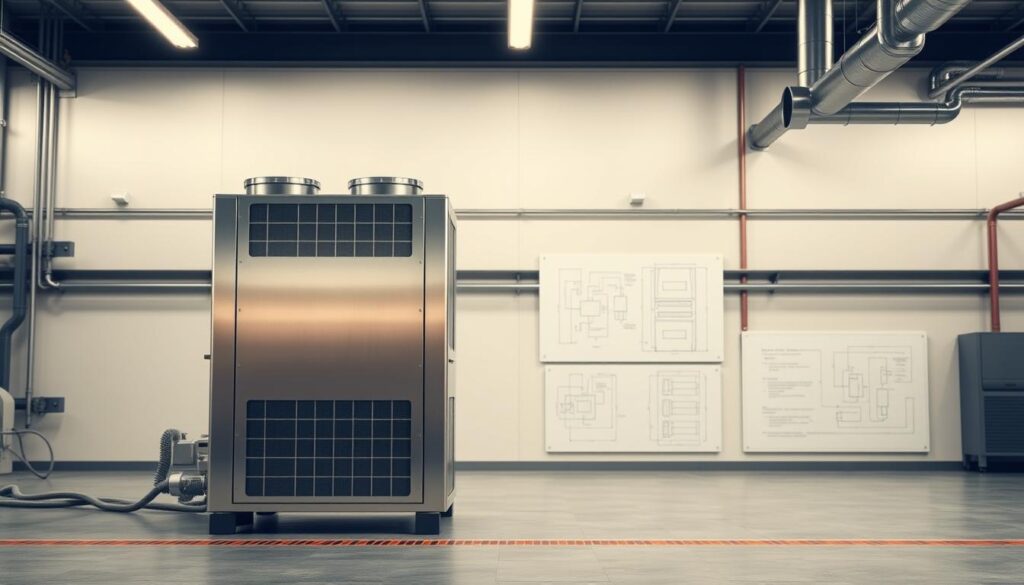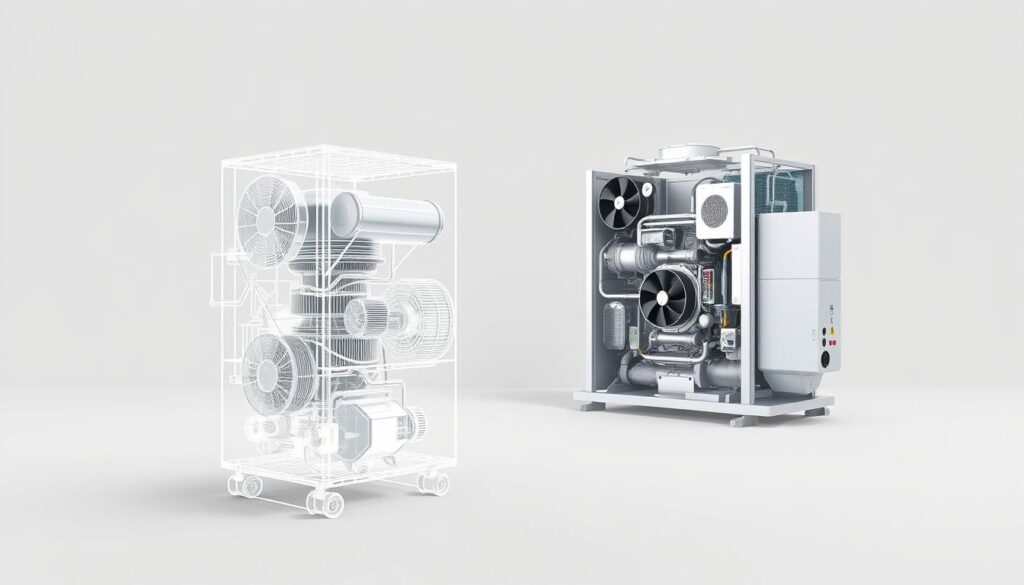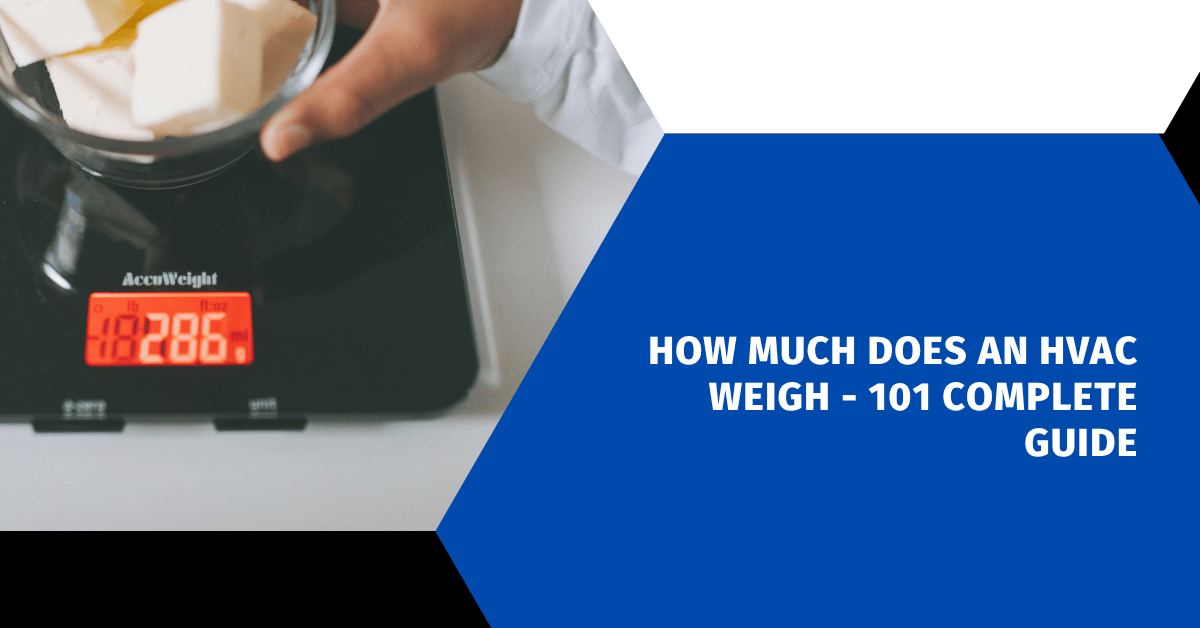Affiliate Disclosure
HVAC Guide Guys is a participant in the Amazon Services LLC Associates Program, an affiliate advertising program designed to provide a means for sites to earn advertising fees by advertising and linking to Amazon.
Ever thought about how much your home’s cooling and heating system weighs? Knowing the weight of an HVAC unit is key. It affects everything from structural support to installation challenges. Understanding your HVAC unit’s weight can save you time, money, and headaches.
A typical air conditioner’s outside unit weighs between 150 to 210 pounds. This is surprisingly heavy. When you’re planning to install or replace your HVAC system, knowing its weight is essential for proper planning.

This guide will cover the details of HVAC system weights. We’ll look at everything from residential units to commercial installations. Whether you’re a homeowner, contractor, or just curious, you’ll learn about the weight of these important home comfort solutions.
Key Takeaways
- Residential HVAC units typically weigh between 150-210 pounds
- Weight impacts installation, transportation, and structural requirements
- Different HVAC types have varying weight specifications
- Professional assessment is key for proper HVAC selection
- Modern HVAC systems are becoming more compact and lightweight
Table of Contents
Understanding HVAC System Weight Basics
Knowing the weight of HVAC systems is key for homeowners and pros. The weight of an HVAC system changes based on many factors. This includes the type of unit and its design. The weight of your air conditioner affects installation, performance, and efficiency.
HVAC systems are often measured in tons. This doesn’t mean their actual weight. It shows how much cooling they can handle, in British thermal units (BTUs).
Different Types of HVAC Units
Every HVAC unit has its own weight:
- Central air conditioners: Usually weigh 150-250 pounds
- Heat pumps: Usually weigh 150-300 pounds
- Furnaces: Can range from 100-200 pounds depending on size
Factors Affecting HVAC Weight
Several things affect an HVAC system’s weight:
- Materials used in construction
- Technological complexity
- Energy efficiency ratings
- Size and capacity of the unit
Weight Impact on Installation
The weight of your HVAC system affects installation. Heavier units need:
- Stronger structural support
- Specialized transportation equipment
- Professional handling techniques
- Precise placement considerations
Understanding these weight dynamics helps you make informed decisions about your HVAC system selection and installation.
Explore Our HVAC Shop
Looking for top-rated HVAC tools, parts, and accessories? Visit our shop and find the perfect solution for your needs.
Visit the ShopResidential HVAC Unit Weights
Knowing the weight of your HVAC system is key when you’re planning to install or replace it. A typical air conditioning system for homes can vary a lot in weight. This depends on its parts and how big it is.
The weight of HVAC units for homes can change a lot. This is because of a few important things:
- Outdoor condensing units usually weigh between 150-210 pounds
- Indoor air handlers can weigh from 80-120 pounds
- Furnace weight depends on its size and what it runs on
When it comes to furnace weight, gas models are usually heavier. A standard gas furnace for homes can weigh between 100-200 pounds. Electric furnaces, on the other hand, are lighter, weighing from 50-125 pounds.
Where you put the HVAC unit is also important:
- Attic installations need careful checks on the structure
- Basement units require the right support
- Outdoor units need solid ground to stand on
Pro tip: Always talk to a professional HVAC technician. They can make sure your home’s structure can handle the weight of your chosen system.
Proper weight distribution is key to long-term HVAC system performance and longevity.
Explore Our HVAC Shop
Looking for top-rated HVAC tools, parts, and accessories? Visit our shop and find the perfect solution for your needs.
Visit the ShopCommercial HVAC System Weight Considerations
Weight is key in designing and installing commercial HVAC systems. They are much more complex than home systems. This requires special engineering and planning.
It’s vital for building managers and engineers to understand the challenges of HVAC weight. Different factors affect the system’s needs and how it fits into the building.
Building Type and Size Impact
Commercial HVAC systems change a lot based on the building. Important factors for weight and installation include:
- Square footage of the facility
- Occupancy levels
- Specific industry requirements
- Energy efficiency standards
Load Calculations for Commercial Units
Getting the load right is key for choosing the right HVAC equipment. The Air Conditioning Contractors of America (ACCA) suggests looking at several things:
- Building application
- Structural capacity
- Energy consumption
- Performance specifications
Weight Distribution Requirements
Ensuring the system’s weight is evenly distributed is important. This prevents damage to the building. Key things to consider are:
| Consideration | Impact |
|---|---|
| Roof Load Capacity | Determines maximum equipment weight |
| Mounting Structure | Supports even weight distribution |
| Structural Engineering | Ensures safety and long-term performance |
By carefully looking at these weight factors, you can make your commercial HVAC system work better and last longer.
How Much Does an HVAC Weigh by Component Type
Understanding the weight of each HVAC part helps you see how complex your system is. Each part has its own weight, affecting how easy it is to install and move. It also impacts how well your system works.

The weight of an HVAC unit changes a lot depending on the part. Here are some typical weights you might find:
- Condensing Units: 60-150 pounds
- Air Handlers: 50-200 pounds
- Evaporator Coils: 25-75 pounds
- Furnaces: 100-250 pounds
- Ductwork: 1-2 pounds per linear foot
The weight of your air conditioner depends on a few things. These include the unit’s size, how efficient it is, and its technology. Home systems usually weigh less than those for businesses.
| HVAC Component | Average Weight Range | Installation Considerations |
|---|---|---|
| Window AC Unit | 60-120 pounds | Requires sturdy window frame support |
| Split System Outdoor Unit | 100-200 pounds | Needs concrete pad or mounting bracket |
| Rooftop Commercial Unit | 500-2000 pounds | Requires professional structural assessment |
When you’re planning to install your HVAC, think about the weight of each part. HVAC experts can guide you on the specific weights you’ll need for your place.
Explore Our HVAC Shop
Looking for top-rated HVAC tools, parts, and accessories? Visit our shop and find the perfect solution for your needs.
Visit the ShopWeight Variations in Modern HVAC Systems
HVAC technology keeps getting better, leading to changes in system design and weight. Now, homeowners and building managers can choose from advanced, lightweight systems. These systems offer better performance and save energy.
The latest HVAC systems aim to be lighter without losing function. These changes are changing how we view heating and cooling.
Energy-Efficient Models
Today’s energy-saving HVAC systems are made to be lighter. They have:
- Lighter composite materials
- Streamlined components
- Less weight for replacement
- Compact internal structures
Smart HVAC Systems
Smart tech is making HVAC systems smarter. Intelligent systems now have lightweight sensors and digital parts. This makes them lighter but more powerful.
Compact Design Solutions
Companies are creating smaller HVAC solutions that are lighter. These designs bring benefits like:
- Easier installation
- Lower shipping costs
- Less load on buildings
- Better energy use
Looking at HVAC system weight, today’s tech offers flexible, lightweight choices. These meet many needs in homes and businesses.
Transportation and Installation Weight Guidelines
Moving and setting up HVAC systems needs careful planning and skill. The weight of the HVAC system is key to a safe and efficient setup. Experts in HVAC know how to handle these big units.
Before you start the HVAC installation, think about a few important things:
- Equipment weight and what it needs to stand on
- Tools for lifting and moving heavy things
- Rules for safely handling heavy equipment
- How to spread the weight during installation
Experts use special tools to tackle the weight of HVAC systems. Hydraulic lifts, heavy-duty dollies, and crane systems are used to move big HVAC units safely. These tools help avoid damage and keep workers safe.
Professional HVAC installation needs precision, skill, and the right tools to handle big system weights.
Important safety tips for moving HVAC systems include:
- Wear the right protective gear
- Check the weight before moving
- Make sure the place can hold the weight
- Follow the maker’s instructions for handling
The challenge of managing HVAC installation weight shows why you should hire experts. They know how to safely move and place these systems.
HVAC Unit Size and BTU Relationship
It’s important to know how HVAC unit size, BTU output, and weight are connected. This knowledge helps pick the right system for your place. HVAC systems are more than just their weight; they also measure cooling and heating power.
HVAC systems are measured in tons, which might seem odd at first. This doesn’t mean the system’s weight, but its cooling power. One ton can cool 12,000 British Thermal Units (BTUs) per hour.
Square Footage Calculations
Finding the right HVAC size needs accurate square footage calculations. Here’s a simple guide to estimate your needs:
- Small rooms (100-300 sq ft): 5,000-6,000 BTUs
- Medium rooms (300-500 sq ft): 7,000-8,000 BTUs
- Large rooms (500-700 sq ft): 9,000-10,000 BTUs
Tonnage to Weight Conversion
Tonnage shows the system’s capacity, but it doesn’t directly show its weight. Here’s a useful conversion guide:
| Tonnage | BTUs | Approximate Weight Range |
|---|---|---|
| 1 Ton | 12,000 BTUs | 100-150 lbs |
| 2 Tons | 24,000 BTUs | 200-300 lbs |
| 3 Tons | 36,000 BTUs | 300-450 lbs |
| 4 Tons | 48,000 BTUs | 400-600 lbs |
Keep in mind that actual hvac unit weight can vary. This depends on the model, energy efficiency, and new tech. Your local HVAC expert can give you the best advice for your needs.
Explore Our HVAC Shop
Looking for top-rated HVAC tools, parts, and accessories? Visit our shop and find the perfect solution for your needs.
Visit the ShopWeight Considerations for Roof-Mounted Systems
Roof-mounted HVAC systems bring unique challenges for both commercial and residential properties. The weight of your HVAC system is a key factor in planning these installations. It’s important to consider the structural integrity and load-bearing capacity of your roof.

Professional engineers look at several important factors when checking roof-mounted HVAC systems:
- Building structural design
- Roof material composition
- Weight distribution requirements
- Commercial hvac weight specifications
- Environmental load factors
The American Conference of Governmental Industrial Hygienists (ACGIH) suggests detailed structural checks. They look at:
- Insulation levels between walls
- Construction material strength
- Potential weather-related stress
- Long-term structural impact
| Roof Type | Weight Capacity | Installation Complexity |
|---|---|---|
| Flat Concrete Roof | 20-30 lbs per sq ft | Low |
| Pitched Metal Roof | 10-15 lbs per sq ft | Moderate |
| Wooden Truss Roof | 5-10 lbs per sq ft | High |
Proper planning and professional assessment are key to safe and effective roof-mounted HVAC system installations.
Conclusion
Knowing how much an HVAC weighs is key for homeowners looking to replace or upgrade their systems. The weight of your HVAC affects how easy it is to install, what your home’s structure needs, and how well the system works. This knowledge helps you choose the best heating and cooling for your home.
When picking a new air conditioning or heating system, remember weight is important. Different parts like air handlers, condensers, and heat pumps have specific weights. These weights impact how you can mount them, how you’ll transport them, and what professional installers need to do.
Modern HVAC systems use advanced tech with better weight distribution. These energy-saving models work well and put less stress on your home’s structure. With the help of skilled HVAC pros, you can find a system that fits your home’s needs and works efficiently.
Understanding HVAC weight lets you make smart choices about your home’s comfort systems. With expert advice and knowing the facts, you can pick the best HVAC system. It will meet your needs, be efficient, and fit your home’s structure well.

